Why You Should Give A Damn
About Kitchen Safety.
Think you don't need to worry about Kitchen Safety? Well consider this.
The kitchen was ranked number one of "the most dangerous rooms of the home" in research carried out by the U.S. Home Safety Council. The bathroom came in at number two.
Kitchen Fires, Burns and Scalds... Kitchen Safety.
U.S. fire fighters were called out to 403,000 house fires in 2008 (ref: Centers for Disease Control and Prevention ). The fires claimed 2,755 lives and injured another 13,560 people. 80 per cent of U.S. fire deaths that year occurred in the home (Karter 2009). One person was injured every half hour and one death occurred every 3 hours.
The main cause of residential fires was unattended home-cooking equipment.
Cooking flare-up... Kitchen Safety.
...Kitchen Safety advice from the U.S. Home Safety Council.
Ways to keep your kitchen safe...
- Avoid wearing loose clothing (especially long sleeves) that might catch fire.
- Keep flammable materials like tea towels, pot holders, curtains and paper towels away from the stove.
- Don't leave cooking unattended... kitchen safety demands you turn off the stove if you leave the kitchen.
- Regularly check propane cylinder hoses for leaks with soapy water.
- Keep a "kid-free-zone" of 3 feet around the cooking area to prevent spills of hot food or liquids.
- Use the stove's back burners where possible to keep pots and pans out of reach of youngsters.
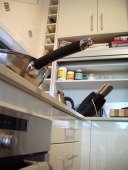
- Turn pot handles away from the stove's edge, away from little fingers.
- Keep appliance cords coiled and away from counter edges.
- Use place mats instead of tablecloths (which can be pulled down spilling containers onto toddlers).
- Use oven mitts when removing hot foods from stoves, ovens or microwaves.
- Never place metal pots, aluminium foil, paper or styrofoam in a microwave. They might damage the oven or start a fire.
- Don't install microwaves too high to prevent hot food spills over face or body.
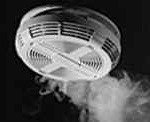
- Install a smoke detector but not so close as to always trigger false alarms.
- Don't microwave infant milk bottles. The formula can get much hotter than the outside of the bottle.
- Microwaved food can be much hotter in the centre than is apparent, seriously burning children.
- Avoid steam burns by opening hot food containers slowly away from your face.
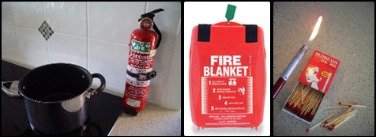
- Keep a fire extinguisher and fire blanket handy.
- Keep matches and lighters away from curious little fingers.
- Do you fight a spreading kitchen fire?... "When in doubt, just get out" (U.S. Fire Administration).
- Never throw water onto a grease fire...you'll cause a flare-up. Smother the flames with a lid and turn off the burner.
- Cigarette butts must be totally extinguished (in sand or water) before being dumped in the kitchen trash bin.
Food and Chemical Poisoning... Kitchen Safety.
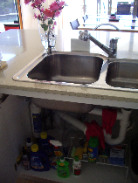
- Lock poisonous cleaning products and insecticides away under the kitchen sink out of kid's reach.
- Always thoroughly wash cooking utensiles after each use.
- Change tea towels, dish cloths and sponges regularly to minimize breeding bacteria. Disposable paper towels
are a good idea.
- Frozen food should be thawed in the bottom shelf of a refrigerator and not taken out until cooking time.
- Thawed-out food should not be refrozen as bacteria can survive.
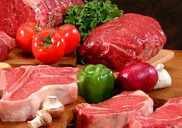
- Food poisoning can result from bacteria in raw food contaminating ready-to-eat food. Always keep raw meats,
fish and eggs seperate from ready-to-eat-food.
- Don't use the same chopping boards and knives for raw and cooked food.
- Take extra care with uncooked eggs in egg-nog, home-made mayonnaise or salad dressing. Salmonella, the most
common bacterial form of food poisoning, can grow inside eggs and contaminate the shell.
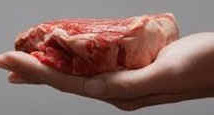
- Thoroughly wash hands after handling raw food and before touching ready-to-eat-food.
- Don't allow bacteria to grow by keeping high risk food in the Temperature Danger Zone... 41°F (5°C) and 140°F
(60°C) . In warm, moist conditions a few bacteria can multiply into millions in several hours.
- Cooking food thoroughly to over 167°F (75°C) will kill most bacteria.
- Left-over cooked food should be cooled and refrigerated with in one hour. Don't put hot food directly
into the fridge.
- Eat left-overs within 2 days.
Choking... Kitchen Safety.
- Around 3,500-4,500 choking deaths occur each year in the U.S. according to National Safety Council and Red Cross
estimates.
- Choking is the leading cause of death under 4 years of age (500-600 children die yearly). This may be because
toddler's incisor teeth can bite food better than their developing back teeth can chew it.
- Particularly dangerous foods are round or cylindrical in shape, sticky and big enough to lodge in a windpipe.

- High risk foods include hot-dogs, grapes, round lollipops, peanuts, marshmallows, popcorn, chewing gum,
chunks of fruit, meat, cheese or raw vegetables.
- Never let children lie down, run around, play or get excited while eating.
- Mashing, grating, peeling away skin and chopping into small pieces is safer.
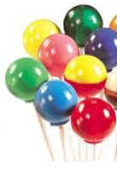
- Other high risk objects are small balls, deflated latex balloons, loose toy parts, buttons, coins,
marbles, etc...
- Keep plastic bags well out of reach of kids to avoid the risk of suffocation.
- Over 4,400 people choked in Japan in 2006 (Health Ministry data). Of these over 85 percent were aged over 65.
The main culprits were "mochi" (pounded) rice cakes, rice, bread and "okayu" rice porridge.
- The Heimlich Maneuver (a series of under-the-diaphragm abdominal thrusts carried out from behind) can save
a choking person, but is not recommended for young children.
Heimlich Maneuver Saves Another Life:... May 6, 2012.
A 6 year old California girl saved the life of her choking best friend and class mate by performing the Heimlich maneuver (which she'd seen carried out in a kitchen safety item on TV).
Dr Henry Heimlich, born 1920, first described his life saving maneuver in 1974. Since then it is credited with having saved over 50,000 lives in the USA alone.
Cuts... Kitchen Safety.
- Keep sharp knives, choppers, mincers and slicers away from little hands. One survey in the United Kingdom
estimated over 67,000 children suffer accidents in the kitchen each year (two thirds aged under 4).
- Every summer children are rushed to emergency centers with cut feet after standing on broken glass on
kitchen floors (which are often tiled and sometimes slippery if wet) with bare feet.

- One Australian study found around of one quarter of emergency hospital admissions from home injuries involved knives
(Monash University Accident Research Centre). Some 80 percent happened during food preparation, while around 11 percent resulted
from knives being washed.
- Don't dispose of broken glass in the regular trash (where thrusting hands might get slashed).
Who Ate My Lunch?
by Eugene Roberts

The Internet Revolution, Globalization, and the Global Financial Crisis created the perfect storm... Old Business models are being destroyed and jobs are disappearing offshore at an astonishing rate. Analysts warn that "China and India are poised to out-think us and out-compete us by their sheer numbers" and that "there is no job security now".
Read more of
Who Ate My Lunch?
for free.






